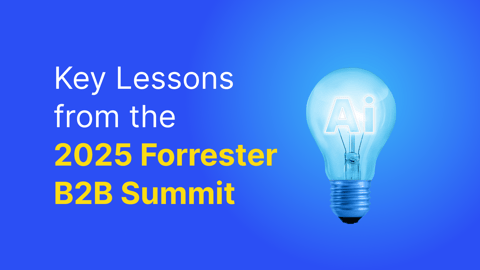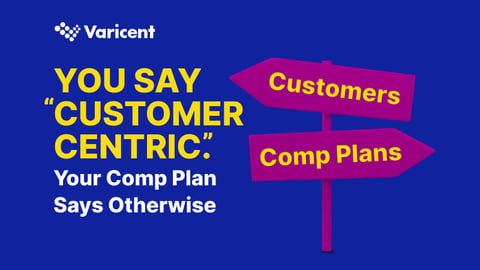This is part of a series of interviews with B2B revenue leaders. This interview is with Amrita Mathur, VP of Marketing at Superside.
Note: at the time of the interview, Amrita was working at TopHat as their VP of Demand Gen and Marketing Ops.
 To start out, tell me about Top Hat and your role with the company …
To start out, tell me about Top Hat and your role with the company …
Top Hat is an exciting company in an exciting space. We just raised a series C and are growing rapidly. One of the reasons I joined the company is that there are really four major problems to tackle in the world today: water, health, transportation, and education. Top Hat is working to solve the problem in education.
Specifically, we’re looking at how to teach students in a better, more modern and interactive way. In today’s distracted classroom, how do we get students to pay attention, absorb the information that’s in front of them, and apply that knowledge? Our mission is to solve exactly that – to make teaching (and learning) fun and effective.
My role at Top Hat primarily deals with customer acquisition, retention, and upsell. I’m the VP of Demand Gen and Marketing Ops and I take that job to be more than just its literal meaning. I see my role as helping Top Hat reach as many educators as possible, and helping these educators see and understand how Top Hat can be beneficial to them and their students.
In the early days, a big focus of mine was on lead lifecycle management including what we consider a lead, how they move through our system, what touch points are warranted, and with what information or messages to target them with. A big part of this is prospect and customer data.
The topic of the day is lead lifecycle process – you helped develop the process at Top Hat, what other experiences do you have?
I’ve worked for many different styles of companies – some late stage startups and then some more established companies – but the common theme is that they're high growth companies looking to scale. To scale, the funnel has to be in good shape before the floodgates get opened, because what's the point of generating leads when we have no idea how to treat them or convert them?
A friend of mine once said this to me … and it’s stuck in my mind, "There are really only two things a Marketer should be focusing on: opening the funnel or fixing it.” Ideally you’d like to be doing both, but there's no point opening up the funnel unless you've figured out the path to conversion – otherwise leads start to leak through and that’s just inefficient, bad business.
Wherever the gaps are in your funnel – the spots or segments where conversion rates are lower than they should be – it’s important to take a good look at what’s working and what’s not working and problem-solve them. No matter what the issue is, the goal is to find what is causing it and take the necessary steps to fix it, whether its process, organizational structure, messaging, product-market fit or whatever. Once that’s done, it’s time to open the floodgates and grow.
After you’ve been in the business for a while, you develop a playbook that you can use almost anywhere. My playbook is simple: identify funnel gaps, check out what’s going on in those stages, fix it, identify tactics that work and open up the floodgates for growth, and repeat.
What’s your opinion on a service level agreement (SLA) between Sales and Marketing?
Having an SLA in place is super important. There's no point having any kind of lead management process in place for your business if there's no agreement between various departments. A lot of people call it an SLA, but I feel like in some ways it’s more like a code of honour between two or more teams.
At Top Hat for example, both Sales and Marketing create pipeline together, which is the case at most B2B companies. It becomes very important for the two teams to have both a good handoff process as well as coordinated plays – AKA how to treat A lead from B lead source and C product interest.
For Sales, it’s them saying:
"Yes, Marketing I accept this qualified lead (or opportunity) and the minute I accept this lead, here's my plan for it, and here are the exact steps I am going to take so this very real person has everything they need to make an informed choice."
For Marketing, it’s them saying:
"Yes, Sales we’re going to produce this volume of leads, at this velocity, and here is the criteria we're going to use to gauge whether it’s a quality lead worthy of your time or not"
Those statements can be fairly extensive, or they can be kept simple, it really depends on the complexity of your business.
What sort of things should be included in an SLA?
The way I see it, there’s three main buckets: lead quality, time to pick-up, and follow-up tactics & messaging.
(1) Lead quality
The worst thing in the world is when Marketing thinks they're doing a great job and producing quality leads, but Sales thinks they are $h!t and don’t bother with them.
So the SLA needs to really define what a quality lead is. It can’t just be that a lead came in with this demographic and did a certain action and so that means they’re interested and can be passed on. It should be a fairly stringent criteria that are agreed upon by both Sales and Marketing.
At Top Hat, we are very clear on the buyer profile as well as the buyer behaviours that constitute a lead that is ready to turn into an opportunity and sales should spend their time on to do hand-to-hand combat.
(2) Time to pick-up
How quickly sales should follow-up on a qualified lead or opportunity is also a big factor. Research has shown that a lead starts to die on the vine in as little as 15 minutes. 15 minutes!!! That’s nothing. So we’ve got to act quickly when someone is qualified and interested.
At Top Hat our BDR team which functions as our lead development team has an SLA to follow up with all AQLs (Automation Qualified Leads) within 15 minutes. This is a tight timeline so they’re constantly looking at their lead queues and making sure they’re helping each out so nothing falls through the cracks.
(3) Follow-up tactics and messaging
The next and perhaps the most underestimated piece is how to follow-up. This is something that many companies don’t pay a lot of attention to, and instead leave it up their talented BDRs to figure out. But BDRs, Marketing, Sales and even company execs might have a big part to play in the development of these tactics.
What kind of things should people think about when it comes to their follow-up strategy?
The follow-up strategy should include:
- What message we want to send in each follow up?
- What medium do we want to use (phone, email, social or some kind of combination)?
- What should the cadence be AKA how aggressive should the follow-up be and how best to time it?
- And once you connect, how do you want to guide the conversation so that it’s a meaningful and consistent experience for the prospect?
At Top Hat, we’re in the process of designing a few broad plays for our leads depending on the last significant action the lead has taken in a certain amount of time.
For example, if someone visits our website and downloads an e-book and watches a few of our customer story videos in a matter of 7 days, we follow up one way. If someone else with the same demographic profile visits our website, signs up for a webinar, and visits the pricing page within 7 days, that follow-up looks very different.
Similarly, a demo request that comes through a Facebook ad vs. organically through our website is also treated differently. The reason for this is that it is an indicator of the prospect’s frame of mind. Ultimately, you’re simply trying to cater your talk track based on the behaviours the lead has taken and where they’ve come through from.
In order to have a process in place, you’ve got to have a tool stack. CRM and Marketing Automation are required, but what other tools have you found to be helpful to optimize the process?
Yes, CRM is super important, so choosing the right one for your company is crucial step. Then making sure the CRM you pick is integrated strongly with your Marketing Automation is big.
As for additional tools, I’ll start out by saying that there are countless tools to helps assist with your lead lifecycle process, but I’ll name a just couple that come to mind.
Yesware is a email automation tool used by our BDRs and sales reps for inbound follow-up and outbound email prospecting respectively. I’ve used SalesLoft in the past which is a bit more sophisticated, but Yesware does the trick.
This one sounds lame, but having a tool like Docusign integrated with Salesforce can be very beneficial. It’ll let you know how many times the proposal or contract has been viewed, and if their going back to look at the legal page versus the pricing page. Those things can let you know what kind of objection handling to be prepared for in the next call.
And then there are the usual data enrichment and data validation tools. You need to find the right ones for your industry of course because each company has a sweet spot.
Companies that want to improve their lead management process – or maybe starting from scratch – how do they start that process? Would it start out with an investment in content creation?
Yeah, I guess the first step could be to produce content to attract inbounds, but it has to be content that caters to the needs of your audience. Sure, you may have been producing content in the past, but maybe for the first time you need to think about catering that content to solve for specific pain points.
Once you've figured out the kind of content you’re going to produce, the next step is to map out what the buying journey looks like. Some companies have four or five different types of buyers and their journeys are all slightly different – that's okay. Your job is to find the common threads, and once do, create your process.
The process can be very simple. The buyer typically does this kind of action, this is usually their pain-point, and this is the type of search they undertake. Great, then you ask – at what point do we capture that lead and what should that process look like internally?
In many cases, BDR/sales outreach may not be required because the prospect is not ready to talk to anybody yet, they're just doing their own thing and that's okay. I refer to this as the prospect being on the education path.
The minute the lead moves from the education path to the conversion path, your lead status/stage should flip, and that should prompt your BDR team to “pick up” the lead and move it to another bucket which could be called “Working”. Then you execute against the followup play books you’ve gotten trained on, and if the lead doesn’t bite, then you move them over to the nurture path.
What the “Working” status allows you to do is say, ‘Out of all these people in my database, here are the ten, twenty, or fifty that I'm catering to in a personalized – one-to-one fashion – based on the information I have.’
Is there a sweet spot number that you'd recommend for a sales rep to have in working at one time?
It's different for different kinds of companies because you could be selling enterprise deals or you could be selling $20 transactional deals, so it's hard to give a blanket answer. Salesforce gives the number of 200, and at Top Hat we allow reps to own and prospect to an unlimited number, but I don’t think any good sales rep can juggle and execute their hand-to-hand combat to more than 200 leads at a time.
If you think about it, you’ve got 40-50 hours in a week, half of which are probably spent planning and working on strategy. That means you’ve only got 20-25 hours a week to communicate with your leads, so even if you spend 10 minutes on each, how could you possibly do more than 200? Those are my thoughts on it.
You mentioned moving leads from working to nurture if they are being unresponsive. What’s the best method to deal with leads set to nurture?
In most companies, nurture turns into a big bucket that everybody throws leads into, and it’s very mismanaged.
I had a conversation with someone on our sales team just last week about nurture being about warming up a lead so that they are buyer ready – which is false. Nurturing is very specific. When you say a lead needs to be nurtured, it means that they’ve engaged with us in some way, but aren’t ready to buy for whatever reason.
Maybe they’re not ready, we couldn't reach them, whatever – they're not ready to buy yet, but we want to keep them warm – that’s the definition of nurturing. Not that they've never heard of you and you're trying to warm them up to make them inbound … that's not it at all.
When it comes to nurturing prospects, there are two tricks to the trade:
(1) Personalization
It should be fairly easy to personalize because you’ve already been in contact with the prospect.
At Top Hat, we collect lots of information about our audience. What we’ve found is that if we’re talking to a chemistry professor, they view themselves as a chemist first and a professor second. So, although they are all professors, we personalize depending on which discipline they teach.
(2) Scalability
You can't be doing one-to-one nurturing, because unlike in "Working", you may have 200,000 prospects being nurtured. How do you scale that? You scale by running a couple different programs that you basically run over time and tweak based on what's happening.
There always needs to be an end goal. A lot of times that consists of a program that sends one email per week as well as some retargeting. That’s great – but what happens if the prospect takes action? Those are the steps people forget to plan. Does a sales rep call them? Great – what happens if they answer? What happens if they don’t? And so on …
How should inbound leads and outbound leads be handled differently?
Ugh, we’re grappling with that issue right now and it’s the bane of my existence. There’s no good answer.
Most are under the impression that inbound leads are hotter leads – or better leads – but the truth is that they’re not ... they’re leads that are aware of your brand. Outbound leads aren't really leads at all, they're just targets that you're trying to capture some kind of interest from. If you capture that interest, then they’re a lead, and at that point they’re no different than inbound.
I’ve been thinking a lot about this topic for a while now, and I’m not sure the old school way of looking at inbound and outbound leads as separate funnels applies anymore. I think everything is nonlinear and integrated these days.
One thing that I remember you speaking about at a conference last year was the idea of taking objections that come at the bottom of the funnel, and solving them further up the funnel. How can an effective lead management process help with that?
If you’re talking to a prospect that’s had a demo, are interested in your product, but you run into the same roadblocks over and over again, you need to find a way to overcome them.
The first step is to identify what those common roadblocks are. The best people to ask for those? Sales reps. Once you have that list – whether it’s a list of two or ten – the next step is to analyze the roadblock(s) and come up with a solution. Once you have that solution, why wait to solve it when the problem actually happens if you can solve it further up the funnel.
A simple example is from my last company where our main buyer commonly needed legal approval, which came from their Chief Legal Officer. That was the roadblock and the solution we decided on was a simple PDF our buyer could send to legal early on in the buying process. This way, the legal team was aware something was happening and was able to set some time aside if and when something came to fruition and more importantly, didn't feel blind sided.
Now I’d like to grab a few of your favorite resources:
A must-follow on Twitter:
I'm a fan of getting practical advice on social media. I think I’ll pick Hiten Shah.
His voice and tone have changed over the last little while but he mainly talks about Marketing. Not just in the dimension context but also as part of the product.
Favorite blog:
I read GrowthHackers like a crazy person. Everything on there is so good and it's such a clever ploy.
Favorite book:
One of my favorite books of all time is something that came out a couple years ago, and it probably sounds cliché, but I love Creativity Inc. by Ed Catmull.
If you haven’t already, you have to read it. I can't really explain it but he is the master of encouraging creativity within the workplace.




